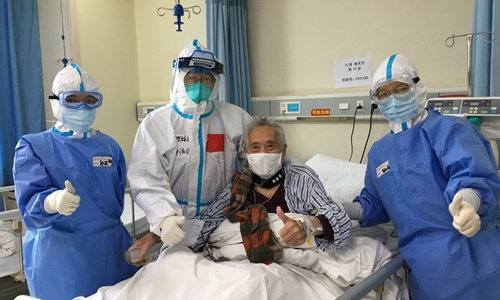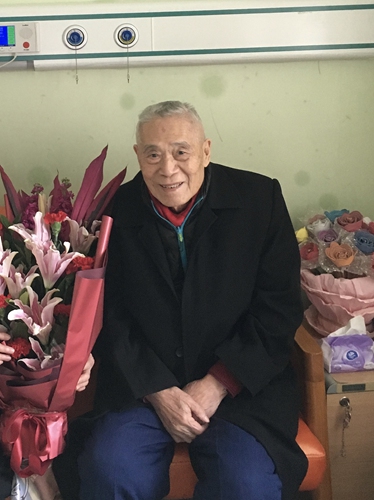98-year-old astronomer recovers from COVID-19 ICU, has a message for those still fighting
By Li Lei Source:Globaltimes.cn Published: 2020/4/23 5:59:44

Han Tianqi poses for a photo with medics in Wuhan Union Hospital. Photo: Courtesy of Han Shijun
At such senior age, Han braved COVID-19 and was recently discharged from hospital after being in critical condition at the intensive care unit of a hospital in Wuhan, capital of Central China's Hubei Province.
"You can see my condition is pretty good now, and 98 is a pretty advanced age," Han said. "Fellow friends, cheer up, and don't be afraid!" He said he wants to encourage patients suffering from the pandemic around the world and share his experience as a survivor of disease.
Arduous journey
Han and his wife tested positive for COVID-19 when the pandemic ravaged Wuhan in the middle of February and they were treated in Wuhan Union Hospital.
On February 23, Han Shijun, the astronomer's granddaughter received the hospital's notice of her grandparents' critical condition. Doctors suggested to her that blood plasma could be an option to save them. She posted the information online to solicit help from those who had recovered from the epidemic.
The public then knew the 98-year-old was a mogul of geodetic astronomy in China.
Han Shijun told the Global Times that after the message soliciting blood plasma was posted, her cellphone was bombarded with messages and calls from people across the country. Many were not infected with COVID-19, but still called to support her.
Doctors combined Han's critical condition with other medical therapies besides blood plasma. On March 12, Han and his wife tested negative to nucleic acid for COVID-19 three times, which means that they could be discharged from the hospital. But considering their age and the physical condition, they were transferred to another hospital for rehabilitation.
On April 15, the couple went home. Han has since had a very good appetite. He said that eating properly is something he learned while fighting the disease in the inpatient ward, as well as his way of repaying the medical workers.
Calligraphy, yellow rice wine and doing physical exercise are Han's favorite things. He rode a bicycle every day after his retirement until he turned 80. Now because of the epidemic, he walks around the balcony to exercise.
Han told the Global Times that he appreciates the medical workers who prioritize patients over their own safety, and he thanks the leadership of the Communist Party of China, which he expressed is like a mother.

Han Tianqi Photo: Courtesy of Han Shijun
Reach for the starsBorn on February 11, 1923, in Xiangshan county of East China's Zhejiang Province, Han was enrolled in a former central surveying and mapping university to study geodetic surveying. After the founding of the People's Republic of China, Han became an assistant research fellow at the Institute of Geographic Sciences.
Han's work was researching 2,628 fixed stars for geodetic surveys, mapping and astronomical timing.
Han has a catchphrase: "People should be like stars in the sky, sticking to a position and giving light to the world." Associates dubbed him the star picker.
At the end of 1953, China introduced WILD T4 universal theodolite to conduct a first-class astronomical survey of the Yellow River. That was when 30-year-old Han participated in the survey and soon mastered the skills to use what was then cutting-edge equipment.
However, Han found the equipment was complicated to use for calculations, as it required a lot of time and energy. He simplified the calculation formulas and results from those formulas identical to the old ones. The little change made the complicated process easier with improved efficiency.
Han's simplified formulas were recognized by the Chinese State Bureau of Surveying and Mapping and became a standard compiled in an official document.
In the following years, Han mapped the positions of 2,628 fixed stars and Zinger star-pairs that were used for geodetic astronomic surveying in China and compiled the optimal procedures to determine locations of astronomical points.
In May 1960, Han was given an order to establish astronomical points in the Qinghai-Tibetan Plateau, filling a blank in China's astronomical surveying in the area. When the truck Han and his team took reached an altitude of 4,000 meters, he suffered from severe altitude stress. A colleague of his suggested he should go back given his severe condition.
Han took out his physical fitness certificate, which proved that he is healthy enough to enter the Plateau. In the back of the certificate, he wrote that before, Princess Wencheng of the Tang Dynasty chose to enter Tibet for ethnic unity, and today, as scientists, we can survive the Plateau.
The note inspired Han and his team. After a month of hard work, Han found the systematic difference value when different operators use different equipment, which solved the problem of personal and instrumental equations in measuring astronomical azimuths.
The first astronomical point established in the Plateau by Han's team was within a high accuracy of about one meter, within one-fifteenth of regular astronomical points.
The 98-year-old still ensures he makes contributions to society. "My advanced age and poor physical condition won't allow me to do scientific research, but I still can do what I can in science popularization," Han told the Global Times.
Before his illness, Han popularized science through the astronomical society of Hubei Province. In the eyes of his granddaughter, Han is a lovely, amiable and humble old man. "He lives a prudent life and almost all his clothes have one or two holes in them, but he never throws them away," Han's granddaughter said.
"Since I was a child, he has always told me to be a person who contributes to society," she added.
Newspaper headline: Star patient
Posted in: PROFILE,FEATURE